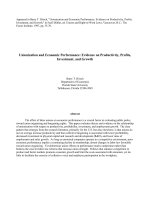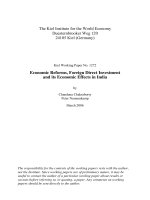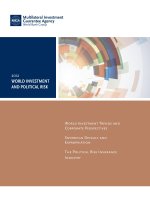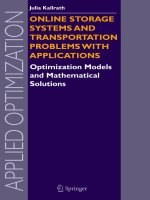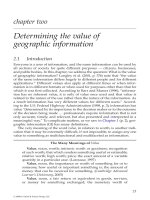Continuous time finite horizon optimal investment and consumption problems with proportional transaction costs
Bạn đang xem bản rút gọn của tài liệu. Xem và tải ngay bản đầy đủ của tài liệu tại đây (1.29 MB, 113 trang )
CONTINUOUS-TIME FINITE-HORIZON
OPTIMAL INVESTMENT AND
CONSUMPTION PROBLEMS WITH
PROPORTIONAL TRANSACTION COSTS
ZHAO KUN
(B.Sc., Fudan University)
A THESIS SUBMITTED
FOR THE DEGREE OF DOCTOR OF PHILOSOPHY
DEPARTMENT OF MATHEMATICS
NATIONAL UNIVERSITY OF SINGAPORE
2009
Acknowledgements
I would like to express my sincere gratitude to my supervisor, Associate Professor
Dai Min, for his selfless and patient guidance over the past four years. He taught
me so much in my graduate study and provided plenty of valuable advices for my
research. I also feel grateful to my former supervisor, Dr. Jin Hanqing, who shared
his knowledge and ideas with me all along the way. What I have learnt from him
in the research is something that will last for many years to come. It would be
impossible for me to meet the standards of Ph.D. thesis without their pure-hearted
instructions.
Especially, I would like to express my heartfelt thanks to Professor Zhou Xunyu
for his sincere, insightful and priceless comments and advices on my thesis which
have motivated me to strengthen the results in this thesis.
I would like to thank my schoolmates Chen Yingshan, Zhong Yifei, Li Peifan,
and Gao Tingting, who spent much time discussing with me over my research and
offered valuable suggestions. My thanks also go out to all other friends who have
encouraged me or given help when I was struggling with this thesis.
My deepest gratitude goes to my family.
ii
Contents
Acknowledgements ii
Summary vi
1 Introduction 1
1.1 Literature review . . . . . . . . . . . . . . . . . . . . . . . . . . . . 1
1.1.1 Optimal investment without transaction costs . . . . . . . . 1
1.1.2 Optimal investment with transaction costs . . . . . . . . . . 4
1.1.3 Connections between singular control and optimal stopping . 8
1.2 Scope of this thesis . . . . . . . . . . . . . . . . . . . . . . . . . . . 9
2 The CRRA Investor’s Optimal Investment Problem with Trans-
action Costs 12
2.1 Formulation of the optimal investment problem . . . . . . . . . . . 12
2.1.1 The asset market . . . . . . . . . . . . . . . . . . . . . . . . 12
2.1.2 A singular stochastic control problem . . . . . . . . . . . . . 13
iii
Contents iv
2.1.3 Properties of the value function . . . . . . . . . . . . . . . . 15
2.1.4 Three transaction regions . . . . . . . . . . . . . . . . . . . 18
2.2 Problem transformation and dimensionality reduction . . . . . . . . 25
2.2.1 A standard stochastic control problem . . . . . . . . . . . . 25
2.2.2 Properties of the new value function . . . . . . . . . . . . . 27
2.2.3 Evolution behavior of the diffusion processes . . . . . . . . . 30
2.2.4 Dimensionality reduction . . . . . . . . . . . . . . . . . . . . 33
2.2.5 Evolution behavior of the new diffusion process . . . . . . . 36
2.3 Connections with optimal stopping . . . . . . . . . . . . . . . . . . 42
2.4 Numerical results . . . . . . . . . . . . . . . . . . . . . . . . . . . . 58
3 The CARA Investor’s Optimal Investment and Consumption Prob-
lem with Transaction Costs 60
3.1 Formulation of the optimal investment and consumption problem . 60
3.1.1 A generalized optimal investment and consumption problem 60
3.1.2 Observations in no-consumption case and dimensionality re-
duction . . . . . . . . . . . . . . . . . . . . . . . . . . . . . 62
3.1.3 Dimensionality reduction in consumption case . . . . . . . . 66
3.2 Characteristics of the optimal investment and consumption problem 68
3.2.1 The existence of W
1,2
p
solution and properties of the value
function . . . . . . . . . . . . . . . . . . . . . . . . . . . . . 68
3.2.2 Characterization of the free boundaries . . . . . . . . . . . . 72
3.2.3 Equivalence between HJB system and double obstacle problem 78
3.2.4 Comparison between the problems with or without consump-
tion . . . . . . . . . . . . . . . . . . . . . . . . . . . . . . . 80
Contents v
3.2.5 Comparison between the problems with or without consump-
tion in the case without transaction costs . . . . . . . . . . . 82
3.2.6 The infinite-horizon optimal investment and consumption
problem . . . . . . . . . . . . . . . . . . . . . . . . . . . . . 83
3.3 The optimal investment problem with jump diffusion . . . . . . . . 86
3.3.1 Formulation of the optimal investment problem with jump
diffusion . . . . . . . . . . . . . . . . . . . . . . . . . . . . . 86
3.3.2 The HJB system and problem simplification . . . . . . . . . 87
3.4 Numerical methods . . . . . . . . . . . . . . . . . . . . . . . . . . . 88
3.4.1 The optimal investment problem . . . . . . . . . . . . . . . 88
3.4.2 The optimal investment and consumption problem . . . . . 91
3.4.3 The optimal investment problem with jump diffusion . . . . 93
4 Conclusion 97
Bibliography 101
Summary
In this thesis, the continuous-time finite-horizon optimal investment and consump-
tion problems with proportional transaction costs are studied. Through proba-
bilistic approach, we investigate the optimal investment problem for a Constant
Relative Risk Aversion (CRRA) investor and reveal analytically the connections
between the stochastic control problem and an optimal stopping problem, with
the existence of optimal stochastic controls and under certain parameter restric-
tions. Besides, the optimal investment and consumption problem for a Constant
Absolute Risk Aversion (CARA) investor is studied through Partial Differential
Equation (PDE) approach. Dimensionality reduction and simplification methods
are applied to transform the relevant (Hamilton-Jacobi-Bellman) HJB systems
to nonlinear parabolic double obstacle problems in different ways and we reveal
the equivalence. Important analytical properties of the value function and the
free boundaries for the optimal investment and consumption problem are shown
through rigorous PDE arguments, while comparison is made between the two cases.
In addition, the jump diffusion feature is incorporated into the optimal investment
problem for a CARA investor and numerical results are provided.
vi
Chapter 1
Introduction
1.1 Literature review
1.1.1 Optimal investment without transaction costs
The optimal investment problem in the financial markets has usually been mod-
eled as optimizing allocation of wealth among a basket of securities. As a pioneer,
Markowitz (1950s) initiated the mean-variance approach for the study of this prob-
lem in the single-period settings, which is a natural and illuminating model. In
such settings, the investors can only make decisions on their capital allocation
at the beginning of the period, and the returns of their portfolio are evaluated
until the end. With the risk of the portfolio measured by the variance of its re-
turn, Markowitz formulated the problem as minimizing the variance subject to
the constraint that the expected return equals to a prescribed level, which turns
out to be a quadratic programming problem. As a result, he obtained the well-
known Markowitz efficient frontier, which reveals the magnitude of diversification
for portfolio management and the optimal tradeoff between risk and expected re-
turn. The historical significance of the mean-variance approach is the introduction
1
1.1 Literature review 2
of quantitative and scientific methods to risk management. This approach pro-
vided a fundamental basis for modern portfolio theory, especially the capital asset
pricing model (CAPM), and inspired thousands of extensions and applications.
After Markowitz’s milestone work, modern portfolio theory has been developed
in multi-period discrete-time settings with the whole investment period divided
by a sequence of time spots into a series of time intervals. In each time interval
between two adjacent time spots, the market is modeled in the same way as in a
single-period model. The multi-period model is more than the simple combination
of a sequence of single-period models on account of the dynamic evolution of the
security prices, which makes the model more practical. The evolution of the prices
embeds uncertainty, often depicted by the increments of the price processes, and
the information flow that possesses the famous Markov property. Mossin (1968),
Samuelson (1969), Hakansson (1971), Grauer and Hakansson (1993), Pliska (1997)
et al have developed portfolio selection theory in multi-period discrete-time set-
tings, while Li and Ng (2000) has provided an analytical result for multi-period
mean-variance portfolio selection problem.
In more delicate continuous-time models, investors are supposed to be able to
make investment decisions at any time during the whole investment period. Often
using Bownian Motion to sketch the continuous-time stochastic processes, these
models are much more complicated than the discrete-time ones, as they cannot
be considered as the limit of the latter by partitioning the investment period into
smaller intervals. Louis Bachelier (1900) firstly introduced Brownian Motion to
evaluate stock option in his doctorial dissertation “The Theory of Speculation”. It
was a pioneer work in the study of mathematical finance and stochastic processes,
but unfortunately his work did not draw enough attention until the 1960s when
stochastic analysis was developed. Subsequently, Black and Scholes (1973) started
to adopt the geometric Brownian Motion to model the evolution of stock prices in
1.1 Literature review 3
their seminal work, and using Brownian Motion to model price evolution has since
become the standard approach in financial theory. For the optimal investment
problem, Merton (1970s) initiated the famous continuous-time stochastic model
embedding Brownian Motion in idealized settings, where the market is frictionless,
or in other words, no transaction cost exists. One risk-free asset and one risky asset
were considered, both of which are infinitely divisible, and the price of the risky
asset is driven by the famous Itˆo diffusion. Generally, an investor wants to make
use of his/her capital as efficiently as possible, and the rules for “efficiency” have
to be defined mathematically. In Merton’s groundwork (1971), expected utility
criteria were employed in Merton’s portfolio problem instead of the Markowitz’s
mean-variance criteria to measure the satisfaction of an individual on the con-
sumption and terminal wealth. Power and logarithm functions were adopted as
utility function to represent the preference of Constant Relative Risk Aversion
(CRRA) investors. Furthermore, Bellman’s principle of dynamic programming, a
robust approach to solve optimal control problem, and partial differential equation
(PDE) theory were used by Merton to derive and analyze the relevant Hamilton-
Jacobi-Bellman (HJB) equation, which is essentially the infinitesimal version of
the principle of dynamic programming. In this idealized setting, he obtained a
closed-form solution to the stochastic control problem faced by a CRRA investor,
and concluded that the optimal investment policy for the investor is to keep a
constant fraction of total wealth in the risky asset during the whole investment pe-
riod, which requires incessant trading. Recent books by Korn (1997) and Karatzas
and Shreve (1998) summarized much of this continuous-time optimal investment
problem.
1.1 Literature review 4
1.1.2 Optimal investment with transaction costs
Merton’s (1971) idealized model has provided a standard approach to formulate the
optimal investment problem for a typical individual investor, and analysis results
have been obtained in the absence of transaction costs. However, in real markets,
investors have to pay commission fees to their broker when buying or selling a stock.
In view of such transaction costs, it has been widely observed that any attempt to
apply Merton’s strategy would result in immediate penury, since incessant trading
is necessary to maintain the proportion on the Merton line. In this case, there
must be some “no-transaction” region inside which the portfolio is insufficiently
far “out of line” to make transaction worthwhile. In the attempt to understand
and explain such phenomenon mathematically, Magil and Constantinides (1976)
introduced the proportional transaction costs to Merton’s model. They provided
a fundamental insight that there exists a no-transaction region in a wedge shape
other than the Merton Line, and also expressed hope that their work would “prove
useful in determining the impact of trading costs on capital market equilibrium”.
However, the analysis of transaction cost models has not yet progressed to the point
where this hope can be realized since the tools of singular stochastic control were
unavailable to these authors. These authors have not given clear prescription as to
how to compute the boundaries or what control the investor should take when the
process reaches the boundaries, hence their argument is heuristic at best. In terms
of rigorous mathematical analysis, Davis and Norman (1990) provided a precise for-
mulation including an algorithm and numerical computations of the optimal policy
for the optimal investment problem where the investor maximizes discounted util-
ity of intermediate consumption, and their work became a landmark in the study
of transaction cost problems. A key insight suggested by Magil and Constantinides
(1976) and exploited by Davis and Norman (1990) is that due to homotheticity of
the value function, the dimension of the free boundary problem associated with the
1.1 Literature review 5
original stochastic control problem can be reduced from two to one. In the analy-
sis of the HJB equation for this problem, Davis and Norman (1990) showed that
the optimal policies are determined by the solution of the free boundary problem
for a nonlinear PDE, and there are two free boundaries indicating separately the
optimal purchasing and selling policies. Under a certain parameter condition, they
also demonstrated that for an infinite horizon investment and consumption prob-
lem with transaction costs, the no-transaction region is a convex cone or a wedge
containing the Merton line, and the proportion of total wealth held in the risky
asset should be maintained inside some interval without closed-form expression.
The results reveal that the optimal transaction policy is an immediate transaction
to the closest point in the wedge if the initial endowment is outside the wedge, fol-
lowed by “minimal trading” to stay within the wedge. The immediate transaction
involves “singular control”, and consumption taking place at a finite rate in the
interior of the wedge involves “continuous control”. Given the existence of singular
control, the problem studied by the authors turns out to be a singular stochastic
control problem, which is much more difficult to handle than Merton’s problem.
Their work served as a cornerstone to rigorously study the singular stochastic con-
trol problem evolved from the optimal investment problem with transaction costs,
but it had the deficiency that the results are acquired under restrictive and not
fully verifiable assumptions. As a further development, Shreve and Soner (1994)
fully characterized the infinite horizon optimal policies under the sole assumption
of the finiteness of the value function, relying on the concept of viscosity solutions
to HJB equations. The viscosity solution approach uses the principle of dynamic
programming to the singular stochastic control problem, assuming only the finite-
ness of the value function, to show that the equation can be interpreted in the
classical sense. In contrast, the classical approach to stochastic control problem
involves construction of a function that solves the HJB equation by extraordinary
1.1 Literature review 6
methods, which usually requires considerable ingenuity and sometimes the intro-
duction of extraneous conditions, and verification that the constructed function is
indeed the value function using the HJB equation. These characteristics make the
classical approach not as powerful as the viscosity approach especially in the case
for singular stochastic control problem. The fundamental study on viscosity the-
ory was initiated by Lions (1982), Crandall and Lions (1983), and Crandall, Evans
and Lions (1984), all of whose papers deal with first-order equations. As the HJB
equation for a controlled diffusion process gives rise to a second-order equation,
the extension of the viscosity theory to second-order equations was developed in
a series of papers by Lions (1983), Jensen (1988), and Ishii (1989). Furthermore,
the use of viscosity solutions in mathematical finance was first studied in the PhD
dissertation of Zariphopoulou (1989), and the applications to stochastic control
problems were reported in the book by Fleming and Soner (1993). By virtue of
the viscosity theory, Shreve and Soner(1994) displayed a comprehensive and robust
approach to analyze the singular stochastic problem generated from the optimal
investment problem with transaction costs.
Now let us consider the phenomenon that financial consultants typically rec-
ommend that younger investors allocate a greater proportion of wealth to stocks
than older investors. Malkiel (2000) stated in his popular book A Random Walk
Down Wall Street that “The longer period over which you can hold on to your in-
vestment, the greater should be the share of common stocks in your portfolio.” In
order to be consistent with this clearly horizon-dependent portfolio rule, the model
must be considered in finite horizon, where the boundaries of the no-transaction
region change as the terminal date approaches. However, it can be seen that the
finiteness of the horizon alone is insufficient to justify the horizon-dependent invest-
ment policy. Taking Merton’s continuous-time optimal investment problem with
idealized settings for example, even though the investor has a finite horizon, his
1.1 Literature review 7
optimal fraction of wealth invested in the stock is still horizon independent. Liu
and Loewenstein (2002) focused on the effect of the horizon on an investor’s invest-
ment policy in the presence of transaction costs, where the optimization problem
became more difficult since the two free boundaries also change through time. The
authors firstly considered the tractable problem with a stochastic time horizon fol-
lowing Erlang distribution, and derived some analytical properties on the optimal
investment policies. They then extended these results to the situation of a deter-
ministic time horizon using the fact that the optimal investment policies of the
Erlang distributed case converge to those of the deterministic time case. In order
to provide a complete study of the finite-horizon optimal investment problem with
proportional transaction costs, Dai and Yi (2009) directly solved the problem faced
by a CRRA investor relying on PDE approach. Motivated by the postulation that
the spatial partial derivative of the value function might be the solution to some
obstacle problem, these authors showed that the resulting equation is linked to a
parabolic double obstacle problem, namely, an ordinary parabolic variational in-
equality problem. The well-developed theory of variational inequality has been very
useful in tackling the challenging singular stochastic control problems, since classi-
cal compactness arguments that are used for establishing the existence of optimal
controls for problems with absolutely continuous control terms do not naturally
extend to singular control problems. Using this theory, they successfully obtained
regularity of the value function and characterized the optimal investment policies
although closed-form solutions are not available. Moreover, Dai et al (2009) took
into account investment and consumption together with transaction costs in finite
horizon and essentially revealed the connections between singular stochastic con-
trol and optimal stopping, while Dai, Xu and Zhou (2010) extended the idea to the
continuous-time mean-variance analysis with transaction costs. In another work,
Yi and Yang (2008) made use of the approach developed in Dai and Yi (2009) to
1.1 Literature review 8
solve a sub-problem arising from the utility indifference pricing with transaction
costs discussed in Davis, Panas and Zariphopoulou (1993). It should be pointed out
that this sub-problem is essentially a finite horizon portfolio choice problem for a
Constant Absolute Risk Aversion (CARA) investor in no-consumption case, while
this thesis studies the consumption case with comparison between the investment
strategies of the two cases. The reason for studying the CARA utility case lies
in the separability of the utility function by which the multi-asset portfolio choice
problem can be reduced to the single risky asset case provided that the assets are
uncorrelated, as investigated in Liu (2004).
1.1.3 Connections between singular control and optimal
stopping
It has long been observed that there exist connections between singular control
problems and certain optimal stopping problems. Such connections were firstly
observed by Bather and Chernoff (1966), who posed a specific control problem,
introduced a related stopping problem, and argued on heuristic grounds that the
optimal risk of the latter ought to be the gradient of the value function of the
former. They also stated that the optimal continuation region in the stopping
problem ought to be the region of inaction in the control problem. Karatzas and
Shreve (1980s) showed by purely probabilistic arguments that, under proper con-
ditions on the cost functions, two typical singular stochastic control problems, the
monotone follower problem and the reflected follower control problem, are equiv-
alent to certain optimal stopping problems in the sense described by Bather and
Chernoff.
Now that the optimal investment problem with transaction costs has been
proven to be a singular stochastic control problem, there seem to be connections
between this problem and the optimal stopping problem as well. However, the
1.2 Scope of this thesis 9
optimal investment problem with transaction costs is a comparatively more diffi-
cult category of singular stochastic control problems, and the connections between
optimal investment and optimal stopping in the presence of transaction costs still
need to be characterized.
1.2 Scope of this thesis
The optimal investment problem with proportional transaction costs in finite hori-
zon, as well as its connections with optimal stopping, is challenging in theory but
interesting in practice. This thesis, for the first time, investigates the continuous-
time finite-horizon optimal investment problem with transaction costs for a CRRA
investor with logarithm utility function and attempts to reveal its connections with
a certain optimal stopping problem through probabilistic approach. Besides, the
continuous-time finite-horizon optimal investment problem with transaction costs
for a CARA investor with exponential utility function is also studied while jump
diffusion feature is incorporated. Another important contribution of this thesis is
that analytical and numerical results are obtained for the continuous-time finite-
horizon optimal investment and consumption problem with transaction costs for a
CARA investor.
In Chapter 2, we attempts to investigate the continuous-time finite-horizon opti-
mal investment problem with transaction costs for a CRRA investor with logarithm
utility function by pure probabilistic arguments, and the problem is formulated as
a singular stochastic control problem. Properties of the value function for this
problem are shown and analytical results are provided for the three transaction re-
gions, which comprises “jump-buy region”, “jump-sell region” and “no-jump-trade
region” and prevails for all the problems we study in this thesis. The jumping styles
1.2 Scope of this thesis 10
of the singular stochastic controls are further investigated, based on which an equiv-
alent standard stochastic control problem is obtained. This equivalent standard
stochastic control problem becomes much simpler than the singular stochastic con-
trol problem since jumps of the diffusion processes arising from the singularity of
controls have been eliminated. A new diffusion process is further introduced so
that the dimensionality of the standard stochastic control problem that innately
contains two diffusion processes is reduced based on the result that the CRRA
investor should never take short position in the risky asset during the horizon ex-
cept the initial time and terminal time. Such simplification enables us to seek the
relation between this stochastic control problem and a certain optimal stopping
problem, especially the connection between the value function of the former and
the optimal risk of the latter, with the existence of optimal stochastic controls and
under certain parameter restrictions. Our work may shed light on future studies on
such optimal investment problem with transaction costs in probabilistic approach.
In Chapter 3, we consider the continuous-time finite-horizon optimal investment
and consumption problem with transaction costs for a CARA investor through
PDE approach, which constitutes the major contribution of this thesis. It is first
observed by probabilistic arguments that the dimensionality of the problem without
consumption can be reduced and the optimal investment strategy for the CARA
investor is indifferent to the initial endowment in the riskless asset. The relevant
HJB systems, in both the no-consumption case and the consumption case, are
then transformed and simplified to two nonlinear parabolic double obstacle prob-
lems separately, while the equivalence is further revealed. Important properties of
the value function and the free boundaries for the optimal investment and con-
sumption problem are revealed analytically by PDE arguments, and comparison is
made analytically between the two cases with and without consumption. Besides,
the infinite-horizon optimal investment and consumption problem is deduced from
1.2 Scope of this thesis 11
the stationary double obstacle problem, which is shown equivalent to the system
obtained in Liu (2004). In addition, since the exponential utility function may tol-
erate negative wealth possibly incurred by the jumping nature, the jump diffusion
feature is incorporated in the CARA investor’s optimal investment problem and a
variational inequality system with gradient constraints is obtained through similar
dimensionality reduction. Finite difference methods are implemented to numer-
ically solve the systems, while the impact of the jump diffusion on the optimal
investment strategy is explained in the end.
Chapter 2
The CRRA Investor’s Optimal
Investment Problem with Transaction
Costs
2.1 Formulation of the optimal investment prob-
lem
2.1.1 The asset market
Throughout this thesis (Ω, F, P, {F
t
}
t≥0
) denotes a fixed filtered complete probabil-
ity space on which a standard {F
t
}
t≥0
-adapted one-dimensional Brownian Motion
B(t) is defined, with B(0) = 0 almost surely. The formulation of our problem,
the continuous-time optimal investment problem with transaction costs in a finite
horizon [0, T ], is based on this filtered probability space.
Suppose that there are only two assets available in the asset market for invest-
ment: one riskless asset (bond) and one risky asset (stock). Their prices, denoted
12
2.1 Formulation of the optimal investment problem 13
by S
0
(t) and S
1
(t) separately, evolve as follows:
dS
0
(t) = rS
0
(t)dt,
dS
1
(t) = S
1
(t)[αdt + σdB(t)].
Here r > 0 represents the constant riskless interest rate, and α > r and σ > 0
stand for the constant expected rate of return and the volatility, respectively, of
the risky asset. These constitute the simplest standard setting of an asset market,
and the investor’s problem is derived from such setting.
2.1.2 A singular stochastic control problem
The investor holds a portfolio that consists of X(t) monetary amount in the riskless
asset account and Y (t) monetary amount in the risky asset account at any time t in
[0, T ], hence the investor’s position at time t may be referred to as (X(t), Y (t)). In
the presence of proportional transaction costs, such position satisfies the following
diffusion equations:
dX(t) = rX(t−)dt − (1 + λ)dL(t) + (1 − µ)dM(t),
dY (t) = αY (t−)dt + σY (t−)dB(t) + dL(t) − dM(t).
(2.1)
Here we use L(·) and M(·) to denote cumulative monetary amounts for buying and
selling the risky asset separately, both of which are right-continuous, non-negative,
and non-decreasing {F
t
}
t∈[0,T ]
-adapted processes with L(0) = M(0) = 0. Note
that due to possible jumps in L(·) and M(·), we shall use X(t−) and Y (t−) on the
right hand side of the stochastic diffusion equations, while the initial endowment
is in fact infused at time 0−. The constants λ ∈ [0, ∞) and µ ∈ [0, 1) represent the
proportional transaction costs incurred on purchase and sale of the stock separately.
As part of the optimization target, the investor’s wealth process is given high
concern. Thus if we define
w(x, y) :=
x + (1 − µ)y, if y ≥ 0,
x + (1 + λ)y, if y < 0,
2.1 Formulation of the optimal investment problem 14
then the net wealth in monetary terms at time t is simply w(X(t), Y (t)). Because
it is natural to require that the investor’s net wealth be positive, we define the
solvency region by
S =
(x, y) ∈ R
2
: x + (1 + λ)y > 0, x + (1 − µ)y > 0
,
inside which w(x, y) > 0 holds spontaneously. The following two notations
∂
1
S := {(x, y) : x + (1 + λ)y = 0, x > 0},
∂
2
S := {(x, y) : x + (1 − µ)y = 0, y > 0},
refer to the two parts of the solvency region boundary separately.
We define the set of square integrable {F
t
}
t∈[0,T ]
-adapted processes as
L
2
F
:=
ξ
{ξ(t)}
t∈[0,T ]
is {F
t
}
t∈[0,T ]
-adapted,
T
0
E[ξ
2
(t)]dt < ∞
,
and the set of square integrable random variables as
L
2
:= {X |X is a random variable, E[X
2
] < ∞} .
Assuming that the investor’s initial endowment (x
0
, y
0
) lies in S, we call the in-
vestment strategy (L, M) admissible if contained in the following admissible set
A :=
(L, M)
{L(t)}
t∈[0,T ]
, {M(t)}
t∈[0,T ]
are right-continuous, non-negative,
non-decreasing, {F
t
}
t∈[0,T ]
− adapted, L(0) = M(0) = 0,
and its governing processes (X(·), Y (·)) ∈ S in [0, T ],
X ∈ L
2
F
, Y ∈ L
2
F
,
X
w(X,Y )
∈ L
2
F
, X(t) ∈ L
2
, Y (t) ∈ L
2
, ∀t ∈ [0, T]
.
This admissible set is clearly nonempty, as the investor can always adopt the
trading policy that closes out the position in the risky asset at initial time and
remains zero position in the risky asset afterwards to satisfy the conditions.
The investor is assumed to be Constant Relative Risk Aversion (CRRA) with
logarithm utility function. The associated utility functional J can then be defined
2.1 Formulation of the optimal investment problem 15
as follows:
J(s, x, y; L, M) := E [log(w(X(T ), Y (T )))|X(s−) = x, Y (s−) = y]
s.t. (2.1).
Mathematically, the utility function log(·) is a real-valued function defined on
(0, ∞), strictly increasing, strictly concave, twice continuously differentiable, and
satisfies lim
w↓0
(log(w))
= ∞. Based on such cost functional, the investor’s problem
under expected utility criteria can be formulated as maximizing the cost functional
over the admissible set A. Denoting the value function by ϕ, the problem may be
described as follows:
ϕ(s, x, y) := sup
(L,M)∈A
J(s, x, y; L, M),
(2.2)
for any s ∈ [0, T ] and (x, y) ∈ S. According to the definition of the admissible set
A, it is not difficult to show ϕ(s, x, y) < ∞ for all s ∈ [0, T ] and (x, y) ∈ S by
applying Jensen’s Inequality.
Problem (2.2) is essentially a singular stochastic control problem, which admits
discontinuous controls, or in other words, allows lump-sum investment strategies.
Such lump-sum investment strategies will be named as “jump-buy” or “jump-sell”
accordingly in most of the cases thereafter.
2.1.3 Properties of the value function
We now introduce several fundamental properties of the value function ϕ of the
singular stochastic control problem (2.2).
Proposition 2.1.1. Given any s ∈ [0, T], ϕ(s, ·, ·) is strictly increasing w.r.t. the
state arguments x and y.
Proof: It is very easy to obtain this property by investing additional mone-
tary amount in the riskless asset while keeping the investment strategy unchanged
afterwards, which makes the value function even larger.
2.1 Formulation of the optimal investment problem 16
Proposition 2.1.2. Given any s ∈ [0, T ], ϕ(s, ·) is concave in S.
Proof: Let (x
1
, y
1
) and (x
2
, y
2
) be in S, and (X
1
(·), Y
1
(·)) and (X
2
(·), Y
2
(·)) be
diffusion processes for problem (2.2) with initial states (X
1
(s−), Y
1
(s−)) = (x
1
, y
1
)
and (X
2
(s−), Y
2
(s−)) = (x
2
, y
2
) while subject to investment strategies (L
1
, M
1
)
and (L
2
, M
2
) respectively. For any η ∈ (0, 1), it is easy to see
(ηx
1
+ (1 − η)x
2
, ηy
1
+ (1 − η)y
2
) ∈ S,
due to the convexity of S. In view of the linearity of the diffusions, the investment
strategy (ηL
1
+ (1 − η)L
2
, ηM
1
+ (1 − η)M
2
) is always admissible for the diffusion
processes with initial states (ηx
1
+ (1 − η)x
2
, ηy
1
+ (1 − η)y
2
) at time s.
In order to obtain the convexity of the value function, we need to consider some
property possessed by the function w(x, y). Without loss of generality, we take any
two points (ˆx
1
, ˆy
1
) and (ˆx
2
, ˆy
2
) in S with ˆy
1
≥ ˆy
2
. It is not difficult to verify the
following results case by case:
w(ηˆx
1
+ (1 − η)ˆx
2
, ηˆy
1
+ (1 − η)ˆy
2
)
= ηw(ˆx
1
, ˆy
1
) + (1 − η)w(ˆx
2
, ˆy
2
), ˆy
1
≥ ˆy
2
≥ 0,
≥ ηw(ˆx
1
, ˆy
1
) + (1 − η)w(ˆx
2
, ˆy
2
), ˆy
2
< 0 ≤ ˆy
1
,
= ηw(ˆx
1
, ˆy
1
) + (1 − η)w(ˆx
2
, ˆy
2
), ˆy
2
≤ ˆy
1
< 0,
the combination of which leads to
w(ηˆx
1
+ (1 − η)ˆx
2
, ηˆy
1
+ (1 − η)ˆy
2
) ≥ ηw(ˆx
1
, ˆy
1
) + (1 − η)w(ˆx
2
, ˆy
2
).
Together with the concavity of the utility function log(·), we have
J(s, ηx
1
+ (1 − η)x
2
, ηy
1
+ (1 − η)y
2
; ηL
1
+ (1 − η)L
2
, ηM
1
+ (1 − η)M
2
)
= E [log(w(ηX
1
(T ) + (1 − η)X
2
(T ), ηY
1
(T ) + (1 − η)Y
2
(T )))]
≥ E [log(ηw(X
1
(T ), Y
1
(T )) + (1 − η)w(X
2
(T ), Y
2
(T )))]
≥ ηE [log(w(X
1
(T ), Y
1
(T )))] + (1 − η)E [log(w(X
2
(T ), Y
2
(T )))]
= ηJ(s, x
1
, y
1
; L
1
, M
1
) + (1 − η)J(s, x
2
, y
2
; L
2
, M
2
).
2.1 Formulation of the optimal investment problem 17
Taking supremum over (L
1
, M
1
) ∈ A and (L
2
, M
2
) ∈ A on the last term of the
inequality, we immediately obtain
ϕ(s, ηx
1
+ (1 − η)x
2
, ηy
1
+ (1 − η)y
2
) ≥ ηϕ(s, x
1
, y
1
) + (1 − η)ϕ(s, x
2
, y
2
),
which completes the proof.
Proposition 2.1.3. Given any s ∈ [0, T], ϕ(s, ·, ·) has the homotheticity property
ϕ(s, ρx, ρy) = ϕ(s, x, y) + log ρ,
for any (x, y) ∈ S and ρ > 0.
Proof: This result follows straightforwardly from the fact that the controls
(L, M) for problem (2.2) governing the diffusion processes (X(·), Y (·)) with initial
states (X(s−), Y (s−)) = (x, y) is admissible if and only if (ρL, ρM) governing the
diffusion processes (X
ρ
(·), Y
ρ
(·)) with initial states (X
ρ
(s−), Y
ρ
(s−)) = (ρx, ρy) is
admissible for all ρ > 0.
Proposition 2.1.4. Given any (x, y) ∈ S, ϕ(·, x, y) is strictly decreasing with
respect to the temporal argument in [0, T ].
Proof: Firstly, for any δt ∈ (0, T ], we choose the investment strategy as closing
out at time T − δt and taking no position afterwards, which induces
ϕ(T − δt, x, y) ≥ ϕ(T − δt, w(x, y), 0) ≥ ϕ(T, w(x, y) · e
rδt
, 0)
= ϕ(T, w(x, y), 0) + rδt = ϕ(T, x, y) + rδt > ϕ(T, x, y).
Next, for any s ∈ (0, T ), and δt ∈ (0, s], we denote by (X
1
(·), Y
1
(·)) the dif-
fusion processes with initial states (X
1
((s − δt)−), Y
1
((s − δt)−)) = (x, y) and by
(X
2
(·), Y
2
(·)) the diffusion processes with initial states (X
2
(s−), Y
2
(s−)) = (x, y).
2.1 Formulation of the optimal investment problem 18
Thus it can be deduced that
ϕ(s − δt, x, y) = sup
(L,M)∈A
E[ϕ(T − δt, X
1
(T − δt), Y
1
(T − δt))]
≥ sup
(L,M)∈A
E[ϕ(T, X
1
(T − δt), Y
1
(T − δt))] + rδt
= sup
(L,M)∈A
E[ϕ(T, X
2
(T ), Y
2
(T ))] + rδt
= ϕ(s, x, y) + rδt > ϕ(s, x, y).
Therefore, we conclude that the value function ϕ is strictly decreasing with
respect to the temporal argument. Intuitively, this property reflects the time value
of investment.
Proposition 2.1.5. Given any s ∈ [0, T ], ϕ(s, ·) is continuous in S.
Proof: For every s ∈ [0, T ], it is easy to observe that ϕ(s, ·) is continuous in
S, since a convex function is always continuous on the interior of its domain. ([41],
Theorem 10.1)
2.1.4 Three transaction regions
As aforementioned, the investment strategy (L, M) ∈ A may possibly admit jumps,
which would make (X(·), Y (·)) jump processes. As usual, we define the jumping
parts of the diffusion processes by
∆L(t) := L(t) − L(t−), ∆M(t) := M (t) − M(t−),
for every t ∈ [0, T ] respectively. Thus the continuous parts of the diffusion processes
can be expressed by
L
c
(t) := L(t) −
s∈[0,t]
∆L(s), M
c
(t) := M(t) −
s∈[0,t]
∆M(s),
2.1 Formulation of the optimal investment problem 19
both of which remain non-decreasing and {F
t
}
t≥0
-adapted but are modified to be
continuous. We further introduce the following notations for t ∈ [0, T]:
∆
b
(t, x, y) := sup{δ ≥ 0 : ϕ(t, x, y) = ϕ(t, x − (1 + λ)δ, y + δ)},
∆
s
(t, x, y) := sup{δ ≥ 0 : ϕ(t, x, y) = ϕ(t, x + (1 − µ)δ, y − δ)},
which intuitively represent the maximal amount the investor are able to buy and
sell at time t without compromising the value function ϕ. As we trivially have
∆
b
(T, x, y) = max{−y, 0}, ∆
s
(T, x, y) = max{y, 0},
at terminal time T, the characteristics of ∆
b
and ∆
s
need only to be studied in
[0, T ) × S.
For our original problem (2.2), it is apparent to see for any (x, y) ∈ S that
ϕ(s, x, y) = sup
(L,M)∈A
E [log(w(X(T ), Y (T )))|X(s−) = x, Y (s−) = y]
s.t. dX(t) = rX(t−)dt − (1 + λ)dL(t) + (1 − µ)dM(t),
dY (t) = αY (t−)dt + σY (t−)dB(t) + dL(t) − dM(t),
∆L(t) = ∆
b
(t, X(t−), Y (t−)), ∆M(t) = ∆
s
(t, X(t−), Y (t−)),
(2.3)
where the investor is required to adopt the investment strategy with maximal
amounts of “jump-buy” and “jump-sell” that would not compromise the value
function ϕ. Such artificial constraint narrows the pool of admissible investment
strategies without affecting the value function, thus it facilitates our further analy-
sis of the problem. Moreover, it is natural to distinguish three transaction regions
for problem (2.3) as follows:
BR
t
:= {(x, y) ∈ S : ∆
b
(t, x, y) > 0},
SR
t
:= {(x, y) ∈ S : ∆
s
(t, x, y) > 0},
NT
t
:= S \ (BR
t
∪ SR
t
),
in which the investor should adopt “jump-buy”, “jump-sell”, or neither at time t
respectively. For convenience of analysis, we denote the interior of NT
t
by NT
t
.

